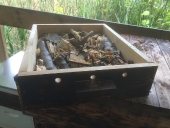


Unofficial Companion Guide to the Rocket Oven DVD
will be released to subscribers in:
soon!







I am an urban homesteader helping my son recover from autism using the Domancic Method of BioEnergy Healing as well as tons of other biomedical approaches and therapies. I support the cause as a freelance Web Designer and Marketing Consultant.




find religion! church
kiva! hyvä! iloinen! pikkumaatila
get stung! beehives
be hospitable! host-a-hive
be antisocial! facespace
 1
1




 1
1








Ernie Schmidt wrote:I very seldom post back to back. I hope this link works. This is what I hope lives in the bottom of my hives. Absolutely incredible.
http://www.beenature-project.com/shop/page/4?sessid=EzaNUdHZDcVBO01BXgUS3CBRSknIyhtrlwuMRQ2oxJXXRhMDEYSaTq4T9PKvkwxv&shop_param
Outdoor and Ecological articles (sporadic Mondays) at http://blog.dxlogan.com/ and my main site is found at http://www.dxlogan.com/




I am an urban homesteader helping my son recover from autism using the Domancic Method of BioEnergy Healing as well as tons of other biomedical approaches and therapies. I support the cause as a freelance Web Designer and Marketing Consultant.
 1
1





Moderator, Treatment Free Beekeepers group on Facebook.
https://www.facebook.com/groups/treatmentfreebeekeepers/









 I posted on the author's youtube channel to get more information about this. I'll let you know if I find out more.
I posted on the author's youtube channel to get more information about this. I'll let you know if I find out more.I am an urban homesteader helping my son recover from autism using the Domancic Method of BioEnergy Healing as well as tons of other biomedical approaches and therapies. I support the cause as a freelance Web Designer and Marketing Consultant.




tel jetson wrote:seems like a reasonable idea. it would sort of approximate a situation common in wild or feral tree cavity hives. some Warré beekeepers use an empty box below the entrance for just such an arrangement. debris that would otherwise fall onto the bottom board and be removed by the bees instead collects in the sump.




"SONG OF INCREASE: Listening to the Wisdom of Honeybees
for Kinder Beekeeping and a Better World"
http://www.SpiritBee.com
east of Battle Ground, WA (near Vancouver)
Friendly Haven Rise Farm
http://www.FriendlyHaven.com





![Filename: Scorpion-like-bug-60-a.jpg
Description: [Thumbnail for Scorpion-like-bug-60-a.jpg]](/t/35494/a/26525/Scorpion-like-bug-60-a.jpg)
Works at a residential alternative high school in the Himalayas SECMOL.org . "Back home" is Cape Cod, E Coast USA.

|
She still doesn't approve of my superhero lifestyle. Or this shameless plug:
The new kickstarter is now live!
https://www.kickstarter.com/projects/paulwheaton/garden-cards
|




